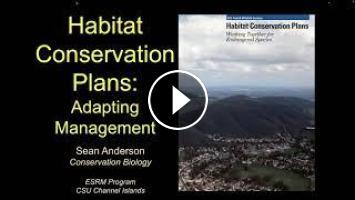A habitat conservation plan (HCP) is a document that meets federal Endangered Species Act (ESA) requirements and enables local agencies to allow projects and activities to occur in endangered species’ habitats. In exchange, those projects and activities must incorporate HCP-prescribed measures to avoid, minimize, or compensate for adverse effects on natural communities and endangered species.
An HCP extends its federally granted endangered species permit—known as take authorization—to all projects and activities it covers. Loosely defined, take means to injure or kill a listed species or alter the habitat on which it depends. Although the ESA prohibits take of listed species, under some circumstances take can be authorized by permit to agencies, developers, and other entities engaged in otherwise lawful activities. The HCP process recognizes the impact of land use activities and establishes a program to provide for a net benefit to specific species (i.e., covered species).
Without a regional HCP in place, local governments, private entities, or individuals evaluate projects and activities individually in consultation with a variety of federal and state regulators to mitigate for potential impacts on species. This is a lengthy process that can cost all parties considerable time and money. This approach also does less to protect wildlife because project- or activity-specific mitigation measures result in land being set aside on a piecemeal basis, resulting in fragmented habitats that are less ecologically viable and also more difficult to manage.
Regional HCPs are a relatively new tool for protecting endangered and threatened species and represent an important integration of land use planning, regional and interagency coordination, and habitat conservation. HCPs offer a more efficient process for protecting the environment and processing applications for local projects and activities that may affect endangered species and their habitats.
The HCP is the federal counterpart to the State natural community conservation plan (NCCP) providing a means of complying with the Natural Community Conservation Plan Act and securing take authorization at the State level. The NCCP Act is broader than federal ESA and the California Endangered Species Act (CESA). The primary objective of the NCCP program is to conserve natural communities at the ecosystem scale while accommodating compatible land uses. To be approved by the the California Department of Fish and Wildlife, an NCCP must provide for the conservation of species and protection and management of natural communities in perpetuity within the area covered by permits.
NCCPs are different from HCPs because the NCCP Act requires that conservation actions improve the overall condition of a species, whereas HCPs typically only require avoidance of a net adverse impact on a species. And while an HCP can be applied at a project-by-project or regional scale, an NCCP must be applied at the regional scale to promote the long-term recovery of species, protection of habitat and natural communities, and diversity of species at the landscape-level. Thus the State requirements go “above and beyond” the federal mitigation requirements.
We will discuss the early efforts of these tools using San Bruno Mountain as the key example, driven by three (and now four) endangered butterfly species. We close out with a discussion surrounding the Placer County Conservation Plan (fully implemented in 2021).
An HCP extends its federally granted endangered species permit—known as take authorization—to all projects and activities it covers. Loosely defined, take means to injure or kill a listed species or alter the habitat on which it depends. Although the ESA prohibits take of listed species, under some circumstances take can be authorized by permit to agencies, developers, and other entities engaged in otherwise lawful activities. The HCP process recognizes the impact of land use activities and establishes a program to provide for a net benefit to specific species (i.e., covered species).
Without a regional HCP in place, local governments, private entities, or individuals evaluate projects and activities individually in consultation with a variety of federal and state regulators to mitigate for potential impacts on species. This is a lengthy process that can cost all parties considerable time and money. This approach also does less to protect wildlife because project- or activity-specific mitigation measures result in land being set aside on a piecemeal basis, resulting in fragmented habitats that are less ecologically viable and also more difficult to manage.
Regional HCPs are a relatively new tool for protecting endangered and threatened species and represent an important integration of land use planning, regional and interagency coordination, and habitat conservation. HCPs offer a more efficient process for protecting the environment and processing applications for local projects and activities that may affect endangered species and their habitats.
The HCP is the federal counterpart to the State natural community conservation plan (NCCP) providing a means of complying with the Natural Community Conservation Plan Act and securing take authorization at the State level. The NCCP Act is broader than federal ESA and the California Endangered Species Act (CESA). The primary objective of the NCCP program is to conserve natural communities at the ecosystem scale while accommodating compatible land uses. To be approved by the the California Department of Fish and Wildlife, an NCCP must provide for the conservation of species and protection and management of natural communities in perpetuity within the area covered by permits.
NCCPs are different from HCPs because the NCCP Act requires that conservation actions improve the overall condition of a species, whereas HCPs typically only require avoidance of a net adverse impact on a species. And while an HCP can be applied at a project-by-project or regional scale, an NCCP must be applied at the regional scale to promote the long-term recovery of species, protection of habitat and natural communities, and diversity of species at the landscape-level. Thus the State requirements go “above and beyond” the federal mitigation requirements.
We will discuss the early efforts of these tools using San Bruno Mountain as the key example, driven by three (and now four) endangered butterfly species. We close out with a discussion surrounding the Placer County Conservation Plan (fully implemented in 2021).
Be the first to comment













